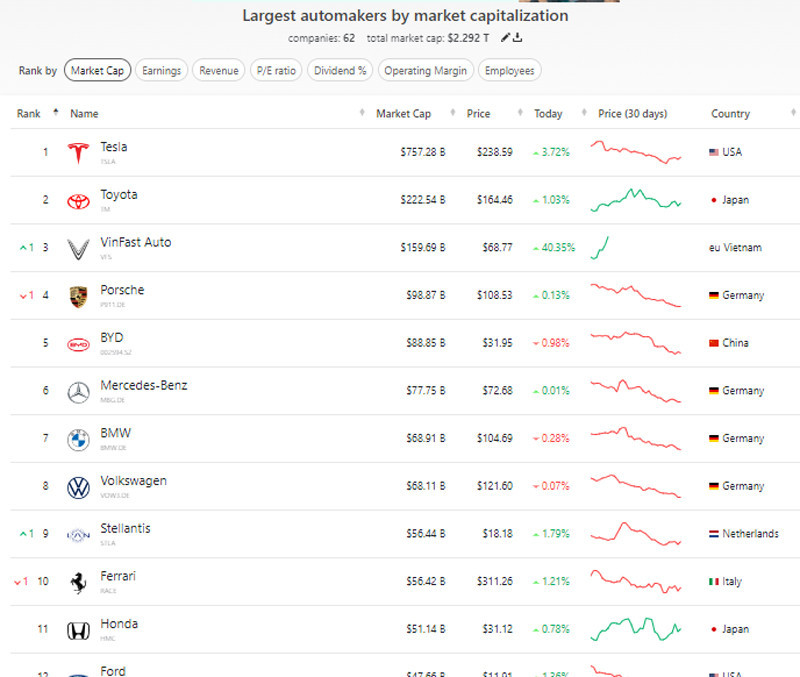
At the last trading session on August 25, VinFast shares (VFS) of billionaire Pham Nhat Vuong continued to cause a shock to the public when closing at the new record high of $68.77 per share, which meant the capitalization value of $160 billion for the automobile manufacturer.
Over 12.9 million units were traded that day and VFS price once escalated to $72.5 per share, which meant the capitalization value of $170 billion.
As such, VFS prices increased in all the five trading sessions of the last week and increased sharply by 4.5 times, or 346 percent. VFS prices soared from $15.4 per dollar at the end of the week before to $68.77, an unimaginable increase.
VFS made its debut on Nasdaq on August 15 when its closing price was $37 per share (or $85 billion in capitalization value), the figure that VinFast’s managers admitted was unexpected. But after that, VFS prices decreased sharply in the next three sessions and dropped to $13 per share.
However, at the trading session opening a new week, August 21, VFS prices soared again. Closing the session, VFS prices had increased by 14.2 percent from $15.4 to $17.58 per share, and its capitalization value reached $40 billion.
VFS once again caused a surprise on the next day, August 22, when it soared by twofold to $36.72 per share and once broke the $40 per share threshold at the session.
The August 23 trading session continued witnessing the price increase of VFS, closing at $37.03 per share.
A new record was made on August 24 with the closing price at $49 per share and 8 million shares traded. The prices once climbed to $58 per share, which meant the value of $130 billion for the automobile maker.
And VFS once again gives all securities investors a start when its prices jumped to $68.77 per share in the last session of the last week, where 12.9 million units were traded.
Analysts have calculated that by gaining in all the five sessions of the week, VinFast’s average capitalization value increased by $24 billion a day.
Vuong’s assets fluctuate
The sharp rise in VFS prices has helped Vuong’s assets skyrocket to $55.8 billion by August 25, with which, he has become the 23rd richest billionaire in the world, the third in Asia and the first in Southeast Asia.
However, the VFS heavy price fluctuations seemingly have made rating firms, including Forbes and Bloomberg, feel puzzled.
On August 21, VFS prices increased by 14.2 percent, making Vuong’s assets increase by $2.2 billion to $23.5 billion, with which Vuong was placed in the 68th position on the list of wealthy people in the planet.
On August 22, the two-fold price increase once again made Vuong’s assets increase by another $20.3 billion to $43.7 billion, with which Vuong jumped to the 27th position.
When VFS prices moved up to the new record high at $37.03 per share on August 23, analysts thought that Vuong’s assets would increase proportionally. However, after the session, Forbes put Vuong at the 45th position (down by 18 grades).
This was the second adjustment made by Forbes to Vuong’s position since VFS made debut on Nasdaq.
Prior to that, on August 16, Forbes reported that Vuong had $84 billion and ranked 16th in the world. However, just several hours later, it made some adjustment, lowering the assessed value to the level similar to Bloomberg’s valuation, at over $44 billion, which meant Vuong was among top 30.
One day later, August 24, when VFS prices soared to $49 per share, VinFast’s capitalization value soared to over $110 billion, while Vuong’s assets increased by another $8.9 billion to $41.1 billion, which helped Vuong jumped from the 45th to the 28th and continue to be the richest person in Southeast Asia.
On August 25, according to Forbes, Vuong had $55.8 billion, becoming the third richest person in Asia.
Meanwhile, Bloomberg hasn’t made calculations and released any statement about Vuong’s assets. Vuong’s name is no longer found in Bloomberg’s list of billionaires. Before VinFast listed shares on Nasdaq, Bloomberg estimated that Vuong had had $5-5.9 billion.
If compared with Vietnamese enterprises, VinFast’s capitalization value is twice as much as the total capitalization value of 10 largest listed companies.
Manh Ha